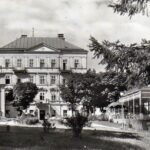
In the old chronicles it is written “A.D. 1833 a mill on the Metternich estate was built by the miller Johan Schneider”. Lesní mlýn actually served the mill operation and, as usual, the sawmill operation. From the very beginning, however, it was also an inn, initially small, but gradually growing and frequently visited. It is said that Prince Metternich himself often stopped, but more because of the beautiful miller’s wife.


As early as 1837, Lesní mlýn (Muhlen-Wirthaus) with its bowling alley was mentioned as a popular destination for walks, also thanks to the immediate vicinity of the Forest Spring. However, the official operation of the inn and café is mentioned only during the ownership of the Dietl family in the 1850s. The establishment of the hotel in 1877 is also the end of the mill operation. Under the leadership of Josef Hanslík of Žatec (son-in-law of the Dietls), Lesní mlýn is becoming a very popular café with a restaurant.



Since the turn of the 19th and 20th centuries, Lesní mlýn has been owned by Heinrich Krauss, who was rebuilding and expanding the hotel, thus completing the appearance of the area, which has been preserved in an almost unchanged form. This is how the “golden times” of the hotel began, when the staff of almost 180 members was taking care of the constant influx of guests.

While walking on forest paths around the hotel, you could had met both King Edward VII of England and many other celebrities of the cultural and social life of the time. Many of them liked to stay directly in Lesní mlýn (eg…….) The importance of the Lesní mlýn hotel continued even after the end of the First World War. In 1936, under another owner of Faulkner, Lesní mlýn was the first hotel in Mariánské Lázně to have a garage and a growing number of visitors with cars. Once again, there are daily concerts, dancing every day. The then prices of accommodation in Lesní mlýn were CZK 35 per person and CZK 75 per person with full board.


After World War II, the hotel was renamed to Alhambra, and from 19…. to Donbas. After the reconstruction of the interiors, it became the most important centre of trade union spa recreation.

In 1992, the hotel closed.












